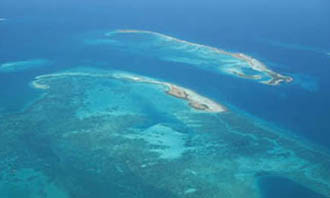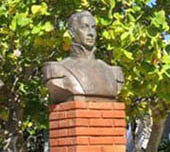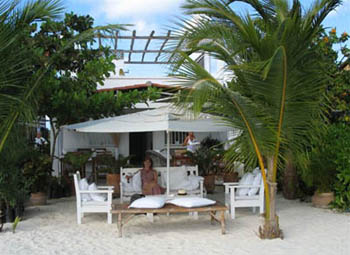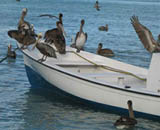The Last Queen of the Caribbean
Los Roques, Islands off the Coast of Caracas
by Sarah Shuckburgh
The inhabitants of Venezuela’s Los Roques archipelago have a passion for beauty
contests. But for outsiders, says Sarah Shuckburgh, the real appeal of these
stunning islands is that they remain pristine and undiscovered.
 There is an air of excitement in the village square.
Darkness has fallen, and dim bulbs dangle from leafy
branches. Hundreds of locals have gathered - children in
fancy dress, babies crawling about on the sand, older people
setting up folding chairs near the stage. A sudden shower
sends the villagers running for shelter under trees and in
doorways. Then there is a power cut, and a further delay
while men fiddle with cables. Excited little girls in party
frocks start mopping the stage. The sound system crackles
into life as seven stern-faced judges take their seats
behind a damask-draped table. They resolutely ignore the
jeers and cheers of the crowd. The show is about to begin. There is an air of excitement in the village square.
Darkness has fallen, and dim bulbs dangle from leafy
branches. Hundreds of locals have gathered - children in
fancy dress, babies crawling about on the sand, older people
setting up folding chairs near the stage. A sudden shower
sends the villagers running for shelter under trees and in
doorways. Then there is a power cut, and a further delay
while men fiddle with cables. Excited little girls in party
frocks start mopping the stage. The sound system crackles
into life as seven stern-faced judges take their seats
behind a damask-draped table. They resolutely ignore the
jeers and cheers of the crowd. The show is about to begin.
First we are entertained by dancers – gawky young men in
tight trousers, moonwalking like Michael Jackson; then four
middle aged couples performing an energetic salsa. Now the
stage is empty again. The music is deafening and the
atmosphere is electric. Banners proclaiming “Viva Elluz” and
“Mariaimy Reina” are hoisted aloft. Suddenly, the backdrop
twitches, there is a shriek from the crowd, and six young
girls parade on to the stage. Aged between twelve and
fifteen, they are dressed in sequinned jumpsuits and
high-heeled sandals, their glossy hair cascading to their
waists, their youthful faces caked with makeup. Arranging
their features into identical pouts, they strut across the
podium, adopt a series of provocative poses, flick their
tresses, and prance off. After a short interval the
contestants appear again, this time in sarongs of shimmering
gold, which they whisk off to reveal skimpy bikinis and dark
childish bodies. As each girl performs a solo wriggling
dance, smiling and blowing saucy kisses at the judges, the
crowd erupts with claps and cheers. I quickly choose my
favourite – Elluz, a sombre girl, who looks as if she would
rather be at home with a book. After another interlude of
dancing by older villagers, the girls appear again, this
time shimmying and cavorting with manic grins, wearing
crinolined carnival dresses and four-foot sparkly
headdresses. After a long delay, they make their final
appearance in demure ball gowns and long white gloves, their
hair lacquered into elegant chignons and strewn with fake
flowers. They walk like zombies, at a snail’s pace, with
expressions glazed and blank.
I have happened upon the climax of the seven-day village
beauty pageant - the final selection of Miss Los Roques.
Beauty competitions are hugely important to Venezuelans, who
are the world’s largest consumers per head of cosmetics.
Candidates who are chosen to represent the country at
international level are accorded unparalleled fame, wealth
and status. Venezuelan beauty queens have won 70
international titles - more than any other nation, and
including at least one major crown every year since the
pageants began in 1952. The competition is intense and the
training is extreme – even at village level, candidates
undergo months of grooming in speech, fitness, hair and
makeup, dance, deportment, and modelling. Later stages
involve cosmetic dentistry and plastic surgery.
At midnight, the judges are ready to give their verdict. By
now, tears of exhaustion streak the young contestants’
maquillage. The villagers are still shouting and waving
banners, hoping, even at the last moment, to influence the
judges’ decision. In this village at least, there are prizes
for everyone. All six girls are presented with embroidered
sashes and bouquets wrapped in cellophane, and there are
bottles of wine and flowers for many of the villagers. But
finally, Mariaimy is crowned as Miss Los Roques. As I leave,
her ecstatic supporters are crowding round, dreaming of her
golden future as Miss Venezuela, Miss Latin America, Miss
International, Miss Earth, Miss World and Miss Universe.
 Los Roques is an idyllic little coral island, a sandy
paradise in a ragged archipelago of 300 islands and 200
reefs and sandbars, all washed by the glittering green and
turquoise Caribbean. In 1972, the area became a marine
national park and one hundred islands are now protected
nature reserves, with restricted access. In these protected
waters, four species of turtle breed, and four types of
mangrove stabilise the coast, providing a safe haven for the
fauna of land and sea, including iguanas, lizards,
salamanders, spiny rock lobsters and the now-rare queen
conch. Ninety two species of birds breed here, including
scissor-tailed frigate birds, herons, terns, lapwings and
plovers, and other migrants from North America. Los Roques is an idyllic little coral island, a sandy
paradise in a ragged archipelago of 300 islands and 200
reefs and sandbars, all washed by the glittering green and
turquoise Caribbean. In 1972, the area became a marine
national park and one hundred islands are now protected
nature reserves, with restricted access. In these protected
waters, four species of turtle breed, and four types of
mangrove stabilise the coast, providing a safe haven for the
fauna of land and sea, including iguanas, lizards,
salamanders, spiny rock lobsters and the now-rare queen
conch. Ninety two species of birds breed here, including
scissor-tailed frigate birds, herons, terns, lapwings and
plovers, and other migrants from North America.
 Time has a different meaning here. The archipelago’s origins
date back 130 million years, but little has touched the
islands since. Indians camped here from the early 14th
century; Spanish explorers charted the islands in 1529 but
didn’t linger. Pirates hid their booty here, but no one
stuck around. It was not until the late 19th century that
Los Roques was settled, when speculators from the Dutch
Antilles began extracting salt from the marshes, lime from
the coral reefs and fertiliser from the mangroves. Time has a different meaning here. The archipelago’s origins
date back 130 million years, but little has touched the
islands since. Indians camped here from the early 14th
century; Spanish explorers charted the islands in 1529 but
didn’t linger. Pirates hid their booty here, but no one
stuck around. It was not until the late 19th century that
Los Roques was settled, when speculators from the Dutch
Antilles began extracting salt from the marshes, lime from
the coral reefs and fertiliser from the mangroves.
Los Roques is still the only island inhabited by humans. The
thriving community of 1500 Roqueńos includes many lobster
fishermen, whose forebears moved here a hundred years ago
from Isla de Margarita. The climate is perfect – warm sunny
days with a refreshing north-easterly breeze, and cool
nights. There is almost no rain. The island’s airstrip is a
mere 30-minute hop from Caracas, and Los Roques is a perfect
place to recover from transatlantic jetlag, or to chill for
a few days before the flight home. I feel instantly revived
and relaxed by my stay here.
 There is only one village - Gran Roque - overlooked by an
eponymous rock, a bald volcanic crag topped by a lighthouse
built by 19th century salt extractors from the Dutch
Antilles. Not much grows here apart from cacti and thorny
scrub, but dense mangrove forests line the beaches of fine
white sand, and tiny hermit crabs scuttle into clumps of sea
pulsane, a creeping plant with thick, water-retaining
leaves. There is only one village - Gran Roque - overlooked by an
eponymous rock, a bald volcanic crag topped by a lighthouse
built by 19th century salt extractors from the Dutch
Antilles. Not much grows here apart from cacti and thorny
scrub, but dense mangrove forests line the beaches of fine
white sand, and tiny hermit crabs scuttle into clumps of sea
pulsane, a creeping plant with thick, water-retaining
leaves.
Brightly painted one-storey cottages line the sandy village
lanes, and the square, also sandy, is presided over by a
statue of Venezuelan hero Simon Bolivar. The church is right
on the beach, with steps leading down to the lapping waves,
and sandy footprints covering the tiled floor.
 I am staying with Valentina, an Italian whose small beach
posada is decorated in impeccable ‘barefoot-luxury’ style,
with white sofas under sunshades, sleek white bedrooms and
luxuriously appointed bathrooms. There is no choice at
dinner, but Valentina presents an al fresco Italian feast –
antipasto (honeyed cream cheese and tuna carpaccio with soy
sauce and almonds), a pasta course, and then a delectable
local lobster, followed by dessert. I am staying with Valentina, an Italian whose small beach
posada is decorated in impeccable ‘barefoot-luxury’ style,
with white sofas under sunshades, sleek white bedrooms and
luxuriously appointed bathrooms. There is no choice at
dinner, but Valentina presents an al fresco Italian feast –
antipasto (honeyed cream cheese and tuna carpaccio with soy
sauce and almonds), a pasta course, and then a delectable
local lobster, followed by dessert.
In the morning, Valentina’s smiling boat boys whizz me out
across the bay, past the long sandy beaches of Crasqui, past
Cayo Pirata with its fishermen’s huts and lobster cages, and
past the strangely shaped houses of Rasqui (built before the
planning restrictions of the marine park) to the island of
Francisqui Medio. While the boys polish and dust the already
immaculate boat, I don mask and snorkel and lower myself
into the warm, sparkling water. Suddenly I am flying over an
exotic and thrilling underwater kingdom. Fish of every
colour and shape glide past – iridescent blue, pale green,
silver, stripy black and white. Huge rays flap silently over
the reef. Bright yellow butterfly-fish with spotted fins
shimmer past parrotfish with dramatic red fins and tails. Tiny angelfish flit and turn as if linked with invisible
threads. A school of bigger fish darts below me, with
impossibly blue heads and tails and vivid yellow bodies.
Black sea urchins wave their spines as crabs sidle by.
 The coral reef is mostly buff-coloured, with rounded
surfaces grooved and patterned like a brain, and knobbly
protrusions like antlers or gnarled twigs. Other parts of
the reef are terracotta red, and there are flimsy fans of
pale veined coral, waving delicately with the currents. The
underwater scene is constantly changing – from light to
dark, from calm to choppy. I float past gaping holes in the
reef, too frightening to swim into. Beds of quivering sea
grass provide refuge for turtles and fat, slug-like sea
cucumbers. Tropical sunshine flickers through the water, and
it is utterly quiet, except for the sound of my own breath
through the snorkel. The coral reef is mostly buff-coloured, with rounded
surfaces grooved and patterned like a brain, and knobbly
protrusions like antlers or gnarled twigs. Other parts of
the reef are terracotta red, and there are flimsy fans of
pale veined coral, waving delicately with the currents. The
underwater scene is constantly changing – from light to
dark, from calm to choppy. I float past gaping holes in the
reef, too frightening to swim into. Beds of quivering sea
grass provide refuge for turtles and fat, slug-like sea
cucumbers. Tropical sunshine flickers through the water, and
it is utterly quiet, except for the sound of my own breath
through the snorkel.
 Later, lazing on Valentina’s beach sofa, I watch pelicans -
hundreds of them - perching on moored fishing boats or
bobbing on the waves. Periodically, each bird heaves itself
into the air and dive-bombs clumsily, its oversized beak
aiming at a passing shoal. As the sun sets, fishing bats
swoop overhead. A gaggle of children walk home through the
dusk, splashing through the lapping waves, and laughing as
they jump over frayed painters tethering fishing boats.
Among them is Elluz, from last night’s beauty contest. Today
she wears shorts and a tee-shirt – a carefree, barefoot,
tousled-headed child again. Later, lazing on Valentina’s beach sofa, I watch pelicans -
hundreds of them - perching on moored fishing boats or
bobbing on the waves. Periodically, each bird heaves itself
into the air and dive-bombs clumsily, its oversized beak
aiming at a passing shoal. As the sun sets, fishing bats
swoop overhead. A gaggle of children walk home through the
dusk, splashing through the lapping waves, and laughing as
they jump over frayed painters tethering fishing boats.
Among them is Elluz, from last night’s beauty contest. Today
she wears shorts and a tee-shirt – a carefree, barefoot,
tousled-headed child again.
Sarah travelled with Sunvil Latin America
First published by the Telegraph
©SarahShuckburgh |